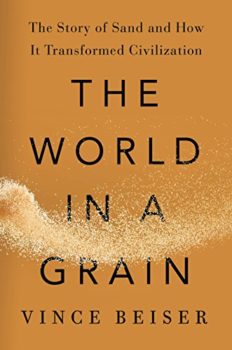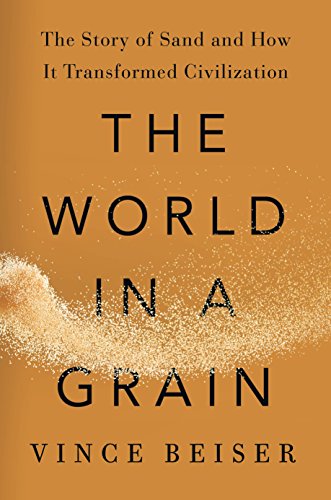
Who knew? We’ve been aware for a long time that humankind is running out of drinkable water and the rare earth elements essential to advanced communications technology. Overfishing is endangering fish populations. And arable land is also growing scarce. But sand? Really? Sand?
Estimated reading time: 6 minutes
Our civilization is built on sand
Well, as journalist Vince Beiser tells us in his revealing study of the subject, The World in a Grain, it’s not strictly true. There’s far more sand in the world’s deserts than we would ever want, and they’re growing. But it turns out that there are numerous varieties of sand. And the stuff in deserts like the Sahara or the Gobi just isn’t suitable for use in concrete. The sand we do need to build all those buildings, manufacture computer chips, and lay all those roads, bridges, and dams is, indeed, becoming scarce. Just as is the case with oil, there may be more than enough of the stuff around, but it’s getting harder, and more expensive, to get it out. The problem is, sand is “about the most taken-for-granted natural resource in the world.” But it’s “the stuff they used to pave paradise and put up a parking lot.”
The World in a Grain: The Story of Sand and How It Transformed Civilization by Vince Beiser (2018) 304 pages ★★★★★
Who knew that the story of sand could be so fascinating?
Beiser’s book is a revelation. Reporting on a subject that could bore us to tears, he has produced a fascinating study of the history of civilization from the perspective of the sand we’ve used to build it. And even his ventures into the complex technical aspects of making concrete and harvesting sand are hard to put down.
Progress is our most important product . . . and it’s killing us
The heart of the problem is the “progress” we celebrate as the fruits of civilization. “At the dawn of the twentieth century, almost all of the world’s large structures . . . were made with stone, brick, clay, or wood. The tallest buildings on Earth stood fewer than ten stories high. Roads were mostly paved with broken stone, or more likely, not paved at all. Glass in the form of windows or tableware was a relatively rare and expensive luxury.”
Producing cement results in releasing 5-10 percent of total carbon emissions worldwide
Then that all changed, as the automobile became a necessity, the science of making concrete advanced, and inventors found ways to automate the production of glass. Today, even though the use of sand in construction goes back at least to 7000 BCE, its use was never so widespread as to require extreme efforts to obtain it. But now “your life depends on sand. You may not realize it, but sand is there, making the way you live possible, in almost every minute of your day. We live in it, travel on it, communicate with it, surround ourselves with it.” And the price we pay is huge: “Cement is made in at least 150 countries, and produces between 5 and 120 percent of the total carbon emissions worldwide.”
You think concrete buildings and roads are permanent? Guess again.
Unfortunately, even though we assume that buildings, dams, and bridges made of concrete reinforced with steel are permanent, that is far from the case. Concrete inevitably weakens over time, and can even collapse if the builders cut corners by using inferior sand. Beiser quotes an expert on the subject, who wrote “Hardly any of the concrete structures that now exist are capable of enduring two centuries, and many will begin to disintegrate after fifty years.” If you’re a member of the Millennial Generation, that may seem like a very long time. But take it from me. It’s not. So don’t expect permanence from a civilization built on sand.
Surprises galore in this fascinating book
The World in a Grain is full of surprises:
- Amazingly, “China alone used more cement between 2011 and 2013 than the United States used in the entire twentieth century.” But that should be no big surprise, since “[t]here are more than 220 Chinese cities with over a million inhabitants” compared to the whole of Europe, which counts only 35.
- The harvesting of sand is nearly universal—”There is no one key source, no Saudi Arabia of sand”—and it’s everywhere damaging. (In fact, “Saudi Arabia is worried about running out of sand.”) Sadly, the increasing competition for sand has led to more and more extreme measures to harvest it. And “[the] process of pulling sand from the earth [and from rivers and oceans] causes at best a little damage, and at worst, catastrophe.”
- The increasing scarcity of sand suitable for use in making concrete and glass has led to the rise of crime. Beiser details numerous horror stories such as this one: “Thieves in Jamaica made off with 1,300 feet of white sand from one of the islands finest beaches in 2008” and “[s]and miners have completely obliterated at least two dozen Indonesian islands since 2005.” Everywhere sand thieves operate, corruption and sometimes even murder comes in their wake.
- While rising ocean levels drown low-lying coastal areas around the globe, efforts by Singapore, Dubai, and Lagos to reclaim land support the “booming market in sand.” Beiser notes that “human beings since 1985 have added 5,237 square miles of artificial land,” which has consumed titanic quantities of sand.
- The roads and buildings we build with sand increase our need for air conditioning. “[P]aved areas can boost the temperature in some cities by as much as 19 degrees Fahrenheit.”
Rising prosperity and overpopulation are the root of the problem
As is the case with the depletion of other natural resources, the increasing difficulty we’re facing is a direct result of overpopulation and the rise of prosperity around the world. “The building methods and materials that a hundred years ago were mostly confined to wealthy Western nations have in the past thirty spread to virtually every country,” Beiser notes. “This epochal shift is what lies behind the sand crisis.”
So, what can be done? There’s really only one way to mitigate the problem, as Beiser sees it: use less stuff . . . and quickly.
For related reading
This is one of the books I’ve included in my post, Gaining a global perspective on the world around us.
You might also be interested in:
- 20 top nonfiction books about history
- Science explained in 10 excellent popular books
- 10 great books on Big History: New perspectives on world history
And you can always find my most popular reviews, and the most recent ones, on the Home Page.



























